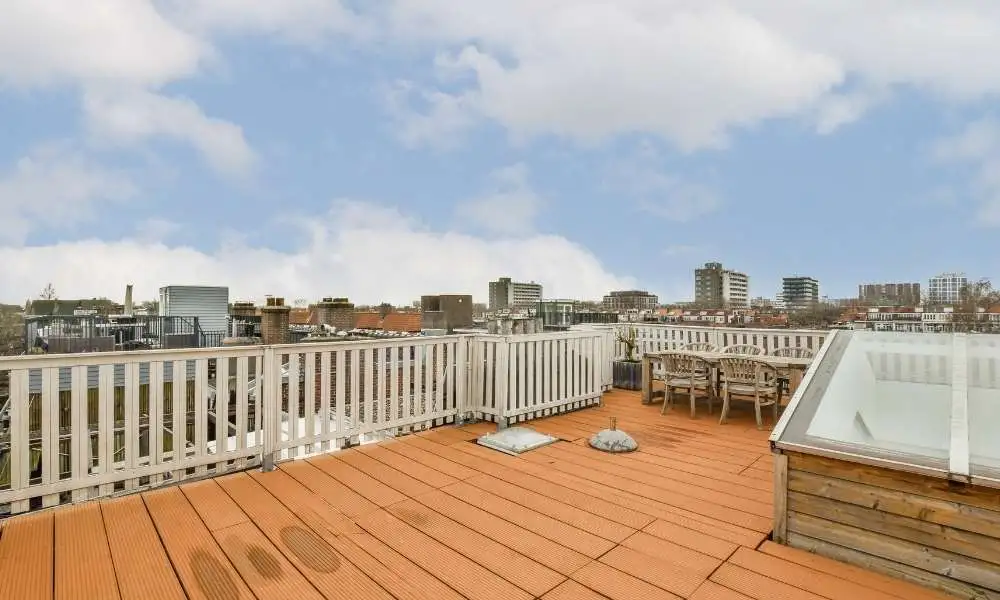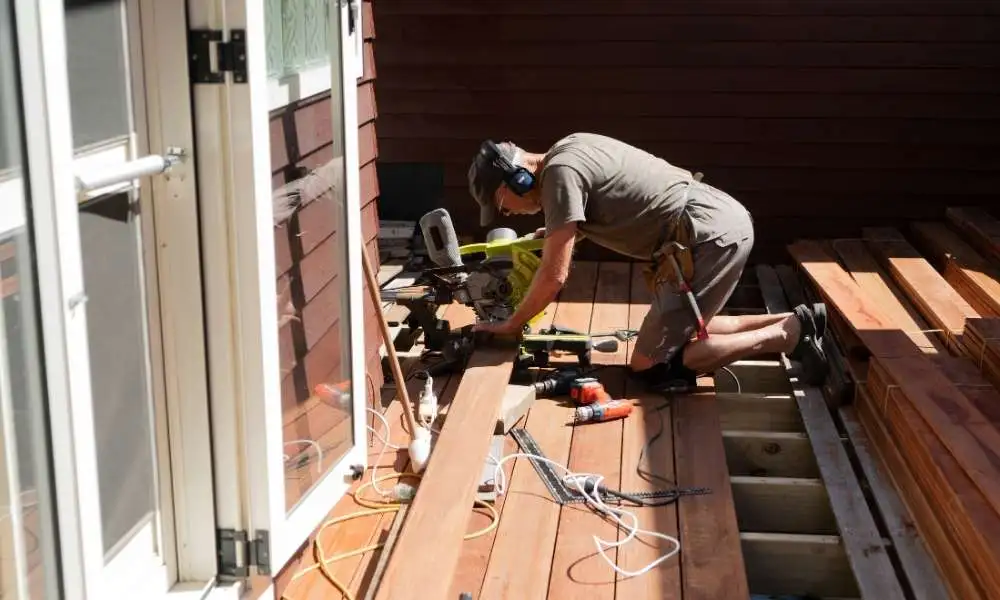An otherwise underutilised area may become a magnificent hideaway with a roof deck, providing panoramic vistas, fresh air, and a distinctive viewpoint on urban life. Creating an oasis where you can relax, party, and take in the beauty of your surrounds from above is just as important as increasing the value of your home. With its elevated attractiveness, a roof deck may blend functionality and visual appeal to become the focal point of your house.
Knowing the basics of building roof decks is essential before you start this interesting job. This isn’t just a do-it-yourself project for the weekend; it’s a methodical procedure requiring forethought, knowledge of structural soundness, and cautious material selection. This tutorial will help you through the necessary stages to construct a roof deck that is not only safe and durable but also a beautiful and relaxing retreat, regardless of your design goals. It may be as simple as creating a place for morning coffees or as complex as creating an entertainment area.
Knowing the Fundamentals: What Is a Roof Deck?

A roof deck is essentially an elevated platform built atop a building’s roof with the intention of creating outdoor living space. Roof decks, in contrast to decks at ground level, need particular attention because of their height and exposure to the weather. They need to be thoughtfully designed to blend in with the architecture of the building and endure different weather.
Roof decks are especially common in urban settings with little outdoor space. They provide a quiet haven away from the bustle of the city, perfect for entertaining guests or using as a place to relax and cultivate. Building a roof deck entails more than just installing wood planks; it also entails seamlessly integrating the area into your home’s existing structure while maintaining safety, comfort, and longevity.
Organising Your Roof Deck
1. Evaluating the Structural Integrity of Your Roof
Determine if your roof can sustain a deck before you start picturing comfortable sitting configurations and lush vegetation. Certain types of roofs may not be able to support the extra weight of a deck, furnishings, and foot activity. It’s crucial to speak with an architect or structural engineer to find out whether your roof needs to be reinforced.
2. Seeking Advice from Experts
Building a roof deck usually needs professional knowledge, even though do-it-yourself projects may be rewarding. In order to guarantee that the deck is secure, complies with regional construction requirements, and is visually beautiful, engineers, architects, and contractors are essential. These experts can guide you through the intricacies of building a roof deck, from obtaining permissions to choosing climate-appropriate materials.
3. Selecting an Appropriate Deck Design
The design of your house and your particular preferences should flow naturally onto your roof deck. Making the appropriate design choice is essential, whether of your preference for a bohemian hideaway with varied décor or a minimalist design with clean lines. Think about the purpose of the area: will it serve as a dining area, a social centre, or a tranquil garden? The intended use of your deck will influence choice of features, materials, and layout.
4. Budgeting
The expense of building a roof deck may rapidly mount up since it is a major investment. Setting a reasonable budget is crucial for everything from high-quality materials to structural reinforcements. To keep your deck looking great, don’t forget to account for regular maintenance in addition to the initial building costs. Recall that a well thought-out budget guarantees you get the best value without sacrificing quality.
Important Things to Think About Before You Begin
1. Being aware of the building codes and permits in your area
Although it might be intimidating, navigating the maze of local construction laws and permissions is an essential stage in the process. Regulations pertaining to roof decks are specific to each municipality and may include limitations on height, setback limits, and safety precautions. Getting the required permissions shields you from possible penalties and the need to take down illegal constructions, in addition to ensuring that your deck is lawful.
2. Taking Your Roof’s Load-Bearing Capacity into Account
One of the most important considerations when building a roof deck is the weight-bearing capability of your roof. This is the most weight your roof is able to sustain, taking into account the weight of the deck, furnishings, occupants, and any extra amenities like hot tubs or plants. If this limit is exceeded, there might be major safety concerns due to structural breakdown. Depending on how the deck is going to be used, strengthening the roof could be required.
3. Making Drainage Plans
In order to avoid water collection, which may lead to leaks, mould growth, and structural damage, proper drainage is crucial. Water should be able to flow away from the building via your roof deck so that it doesn’t collect on the surface or soak into the roof. This often entails installing waterproof membranes, gutters, and drains—all of which need to be skilfully incorporated into the deck design.
4. Water and Weatherproofing Sealing
A roof deck has to be weatherproofed to endure sun, rain, wind, and temperature changes because of its exposure to the elements. This involves choosing materials that are moisture-, UV-, and rot-resistant. To prevent water damage to the underlying roof, waterproofing is equally crucial. Making use of premium sealants, membranes, and coatings can guarantee your deck’s endurance and toughness.
Supplies and Equipment You’ll Need
1. Selecting the Best Materials for Decking
The feel, appearance, and longevity of your roof deck will all depend on the materials you choose. Natural wood, composite decking, and tiles are popular choices. Every material has benefits and drawbacks. For example, composite decking is weather-resistant and minimal care, while wood has a traditional, warm appearance but needs regular upkeep. Tiles are simple to maintain and may provide a sleek, contemporary look.
2. Environmentally Sustainable Choices
Reclaimed wood, bamboo, or recycled composites are examples of eco-friendly decking materials to take into consideration if sustainability is a top concern. These choices lessen their influence on the environment without compromising on performance or flair. The carbon footprint of your deck may be further reduced by using locally produced materials.
3. Crucial Equipment for Deck Construction
A number of instruments, such as power drills, saws, hammers, and levels, are needed to build a roof deck. Additionally required is safety gear such helmets and harnesses, particularly while operating at heights. Having the appropriate equipment on hand guarantees a seamless and effective building process, lowering the possibility of mistakes or delays.
4. Safety Equipment
Never should safety be neglected. There are certain hazards involved while working on a roof deck, thus protective gear is crucial. This comprises safety barriers, rails, and harnesses in addition to personal protective equipment (PPE). Having the proper tools for the job can help you and your crew avoid mishaps and injuries while building.
A Comprehensive Guide to Constructing a Roof Deck
1. Getting Your Roof Ready
The first stage of building is getting your roof ready for the deck. This might include applying a waterproof membrane, fixing any damage, and cleaning the surface. A strong foundation is ensured by careful planning, which guards against problems that can eventually jeopardise the integrity of the deck.
2. Attaching the Support Structure
The support structure, which usually consists of beams, joists, and posts, is the framework of your roof deck. These components need to be positioned in accordance with the deck’s design and firmly fastened to the roof. Here, accuracy is crucial since even little misalignments might result in uneven surfaces or instability.
3. Fastening the Deck Planks
Securing the decking boards comes next when the support framework is in place. For a smooth, long-lasting surface, every board—wood, composite, or tile—must be precisely aligned and secured. Warping, gaps, or loose boards—all of which may be dangerous and unsightly—can be avoided with careful installation.
4. Including Guardrails and Security Elements
In addition to being necessary for safety, railings also provide you a chance to improve the look of your deck. Select components and styles that provide the required protection together with a pleasing overall appearance. Extra safety elements like anti-slip coatings or lights may improve your deck’s usage and safety even more.
Read More: What is a roof deck
Final Details
1. Including Lighting
With the right lighting, your roof deck may become a nightly sanctuary from your daily getaway. To create an inviting environment, think about combining accent, task, and ambient lighting. Popular options that blend style and energy efficiency include solar-powered lighting, string lights, and LED fixtures.
2. Including Greenery and Plants
Your roof deck comes to life with greenery, which softens the hardscapes and adds a hint of nature. Select plants that grow well on rooftops; consider varieties that can withstand wind and dryness. Trellises, vertical gardens, and planters may all assist maximise greens without taking up too much room.
3. Selecting Furnishings
To create a cosy and useful area on your roof deck, the furniture you choose is crucial. Select weather-resistant and easily maintained items. For versatility, think about modular furniture, which lets you change the arrangement for various situations.
4. Producing Shadows
Comfort requires shade, particularly in sunny climes. Pergolas, awnings, umbrellas, and retractable canopies are among the available options. These elements not only shield your deck from the sun, but they also give it more architectural appeal.
Upkeep and Concern
1. Continual Inspection and Cleaning
You need to clean and examine your roof deck on a regular basis to maintain it looking its best. Clear the area of any debris, give it a wash, and look for any wear or damage. Early discovery of problems like water leaks or loose boards might save expensive repairs later on.
2. Fixing Typical Problems
Your deck may have small problems like stains, fractures, or wobbly rails over time. To prevent more severe harm, take quick action to address these issues. Maintaining your deck on a regular basis guarantees that it will be a fun and safe place for many years to come.
3. Periodic Upkeep
Every season, from summer heat to winter snow, presents unique difficulties. As a result, modify your maintenance schedule to shield your deck from the weather. This may include covering furniture, putting on a new coat of sealer, or, in the winter, removing ice and snow.
In summary
Creating a roof deck is a challenging but worthwhile job that may really improve your quality of life. Every phase, from the first planning phases to the last finishing touches, calls for meticulous thought and a dedication to excellence. You may build a roof deck that is both a useful area and a beautiful, long-lasting addition to your house by according to the rules and advice provided in this article. Your roof deck may be the pinnacle of your style and a work of art, whether your goal is for a serene garden, an outdoor lounge, or a bustling party space.
